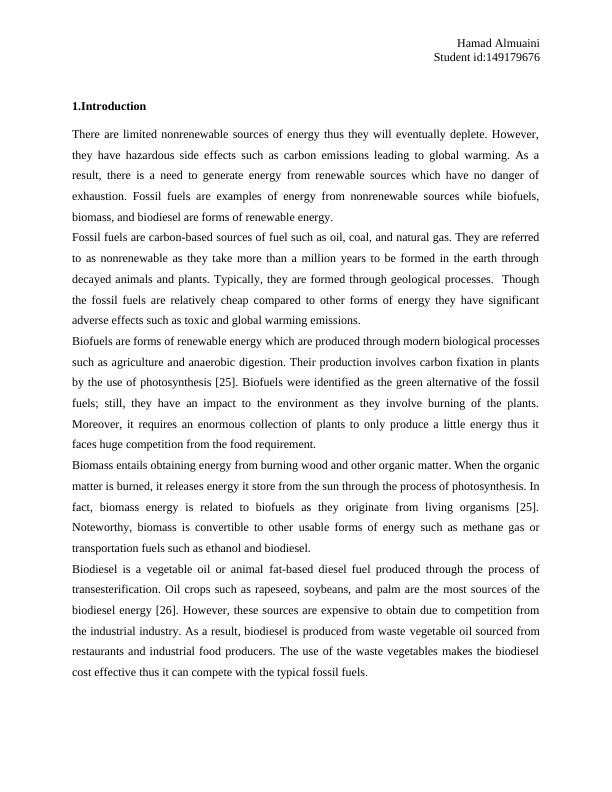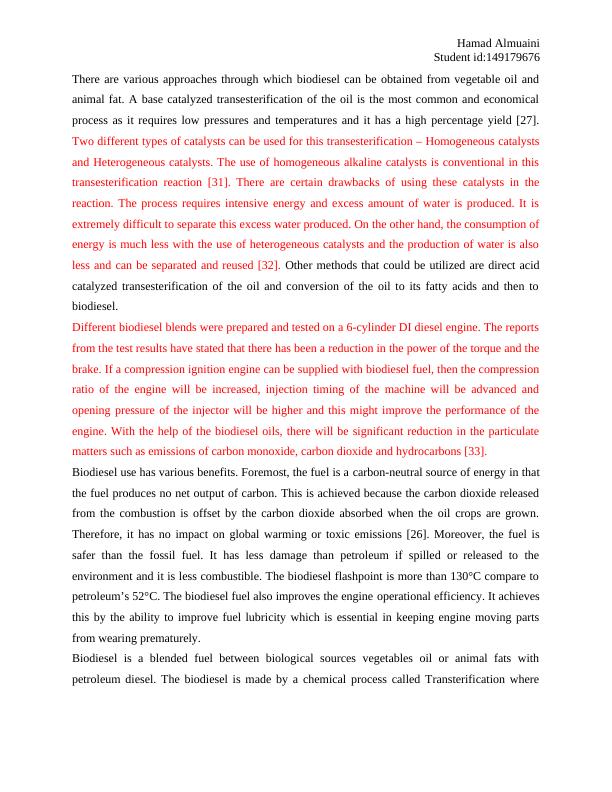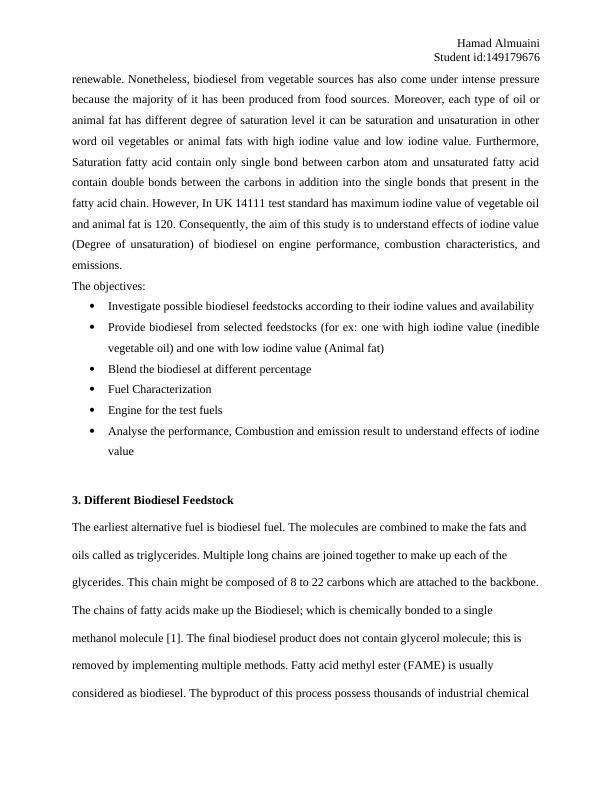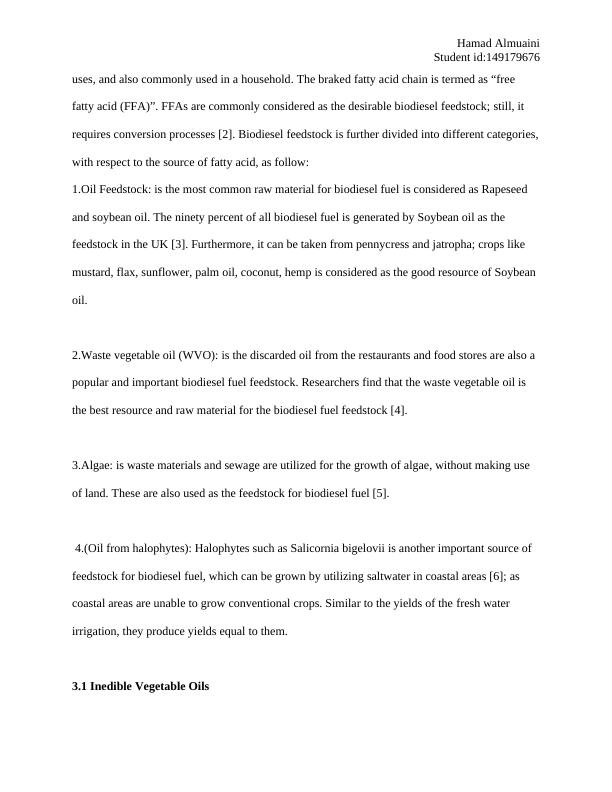The Effect of Iodine Value of Biodiesel Blends from Inedible Vegetable on Engine Performance, Combustion and Emission
Added on 2023-06-15
27 Pages7479 Words364 Views
Hamad Almuaini
Student id:149179676
Biodiesel from Vegetable Oil/ Animal Fat
Hamad Almuaini
Title: The effect of iodine value of Biodiesel blends from inedible vegetable on engine
performance, combustion and emission
Student id:149179676
Biodiesel from Vegetable Oil/ Animal Fat
Hamad Almuaini
Title: The effect of iodine value of Biodiesel blends from inedible vegetable on engine
performance, combustion and emission

Hamad Almuaini
Student id:149179676
1.Introduction
There are limited nonrenewable sources of energy thus they will eventually deplete. However,
they have hazardous side effects such as carbon emissions leading to global warming. As a
result, there is a need to generate energy from renewable sources which have no danger of
exhaustion. Fossil fuels are examples of energy from nonrenewable sources while biofuels,
biomass, and biodiesel are forms of renewable energy.
Fossil fuels are carbon-based sources of fuel such as oil, coal, and natural gas. They are referred
to as nonrenewable as they take more than a million years to be formed in the earth through
decayed animals and plants. Typically, they are formed through geological processes. Though
the fossil fuels are relatively cheap compared to other forms of energy they have significant
adverse effects such as toxic and global warming emissions.
Biofuels are forms of renewable energy which are produced through modern biological processes
such as agriculture and anaerobic digestion. Their production involves carbon fixation in plants
by the use of photosynthesis [25]. Biofuels were identified as the green alternative of the fossil
fuels; still, they have an impact to the environment as they involve burning of the plants.
Moreover, it requires an enormous collection of plants to only produce a little energy thus it
faces huge competition from the food requirement.
Biomass entails obtaining energy from burning wood and other organic matter. When the organic
matter is burned, it releases energy it store from the sun through the process of photosynthesis. In
fact, biomass energy is related to biofuels as they originate from living organisms [25].
Noteworthy, biomass is convertible to other usable forms of energy such as methane gas or
transportation fuels such as ethanol and biodiesel.
Biodiesel is a vegetable oil or animal fat-based diesel fuel produced through the process of
transesterification. Oil crops such as rapeseed, soybeans, and palm are the most sources of the
biodiesel energy [26]. However, these sources are expensive to obtain due to competition from
the industrial industry. As a result, biodiesel is produced from waste vegetable oil sourced from
restaurants and industrial food producers. The use of the waste vegetables makes the biodiesel
cost effective thus it can compete with the typical fossil fuels.
Student id:149179676
1.Introduction
There are limited nonrenewable sources of energy thus they will eventually deplete. However,
they have hazardous side effects such as carbon emissions leading to global warming. As a
result, there is a need to generate energy from renewable sources which have no danger of
exhaustion. Fossil fuels are examples of energy from nonrenewable sources while biofuels,
biomass, and biodiesel are forms of renewable energy.
Fossil fuels are carbon-based sources of fuel such as oil, coal, and natural gas. They are referred
to as nonrenewable as they take more than a million years to be formed in the earth through
decayed animals and plants. Typically, they are formed through geological processes. Though
the fossil fuels are relatively cheap compared to other forms of energy they have significant
adverse effects such as toxic and global warming emissions.
Biofuels are forms of renewable energy which are produced through modern biological processes
such as agriculture and anaerobic digestion. Their production involves carbon fixation in plants
by the use of photosynthesis [25]. Biofuels were identified as the green alternative of the fossil
fuels; still, they have an impact to the environment as they involve burning of the plants.
Moreover, it requires an enormous collection of plants to only produce a little energy thus it
faces huge competition from the food requirement.
Biomass entails obtaining energy from burning wood and other organic matter. When the organic
matter is burned, it releases energy it store from the sun through the process of photosynthesis. In
fact, biomass energy is related to biofuels as they originate from living organisms [25].
Noteworthy, biomass is convertible to other usable forms of energy such as methane gas or
transportation fuels such as ethanol and biodiesel.
Biodiesel is a vegetable oil or animal fat-based diesel fuel produced through the process of
transesterification. Oil crops such as rapeseed, soybeans, and palm are the most sources of the
biodiesel energy [26]. However, these sources are expensive to obtain due to competition from
the industrial industry. As a result, biodiesel is produced from waste vegetable oil sourced from
restaurants and industrial food producers. The use of the waste vegetables makes the biodiesel
cost effective thus it can compete with the typical fossil fuels.

Hamad Almuaini
Student id:149179676
There are various approaches through which biodiesel can be obtained from vegetable oil and
animal fat. A base catalyzed transesterification of the oil is the most common and economical
process as it requires low pressures and temperatures and it has a high percentage yield [27].
Two different types of catalysts can be used for this transesterification – Homogeneous catalysts
and Heterogeneous catalysts. The use of homogeneous alkaline catalysts is conventional in this
transesterification reaction [31]. There are certain drawbacks of using these catalysts in the
reaction. The process requires intensive energy and excess amount of water is produced. It is
extremely difficult to separate this excess water produced. On the other hand, the consumption of
energy is much less with the use of heterogeneous catalysts and the production of water is also
less and can be separated and reused [32]. Other methods that could be utilized are direct acid
catalyzed transesterification of the oil and conversion of the oil to its fatty acids and then to
biodiesel.
Different biodiesel blends were prepared and tested on a 6-cylinder DI diesel engine. The reports
from the test results have stated that there has been a reduction in the power of the torque and the
brake. If a compression ignition engine can be supplied with biodiesel fuel, then the compression
ratio of the engine will be increased, injection timing of the machine will be advanced and
opening pressure of the injector will be higher and this might improve the performance of the
engine. With the help of the biodiesel oils, there will be significant reduction in the particulate
matters such as emissions of carbon monoxide, carbon dioxide and hydrocarbons [33].
Biodiesel use has various benefits. Foremost, the fuel is a carbon-neutral source of energy in that
the fuel produces no net output of carbon. This is achieved because the carbon dioxide released
from the combustion is offset by the carbon dioxide absorbed when the oil crops are grown.
Therefore, it has no impact on global warming or toxic emissions [26]. Moreover, the fuel is
safer than the fossil fuel. It has less damage than petroleum if spilled or released to the
environment and it is less combustible. The biodiesel flashpoint is more than 130°C compare to
petroleum’s 52°C. The biodiesel fuel also improves the engine operational efficiency. It achieves
this by the ability to improve fuel lubricity which is essential in keeping engine moving parts
from wearing prematurely.
Biodiesel is a blended fuel between biological sources vegetables oil or animal fats with
petroleum diesel. The biodiesel is made by a chemical process called Transterification where
Student id:149179676
There are various approaches through which biodiesel can be obtained from vegetable oil and
animal fat. A base catalyzed transesterification of the oil is the most common and economical
process as it requires low pressures and temperatures and it has a high percentage yield [27].
Two different types of catalysts can be used for this transesterification – Homogeneous catalysts
and Heterogeneous catalysts. The use of homogeneous alkaline catalysts is conventional in this
transesterification reaction [31]. There are certain drawbacks of using these catalysts in the
reaction. The process requires intensive energy and excess amount of water is produced. It is
extremely difficult to separate this excess water produced. On the other hand, the consumption of
energy is much less with the use of heterogeneous catalysts and the production of water is also
less and can be separated and reused [32]. Other methods that could be utilized are direct acid
catalyzed transesterification of the oil and conversion of the oil to its fatty acids and then to
biodiesel.
Different biodiesel blends were prepared and tested on a 6-cylinder DI diesel engine. The reports
from the test results have stated that there has been a reduction in the power of the torque and the
brake. If a compression ignition engine can be supplied with biodiesel fuel, then the compression
ratio of the engine will be increased, injection timing of the machine will be advanced and
opening pressure of the injector will be higher and this might improve the performance of the
engine. With the help of the biodiesel oils, there will be significant reduction in the particulate
matters such as emissions of carbon monoxide, carbon dioxide and hydrocarbons [33].
Biodiesel use has various benefits. Foremost, the fuel is a carbon-neutral source of energy in that
the fuel produces no net output of carbon. This is achieved because the carbon dioxide released
from the combustion is offset by the carbon dioxide absorbed when the oil crops are grown.
Therefore, it has no impact on global warming or toxic emissions [26]. Moreover, the fuel is
safer than the fossil fuel. It has less damage than petroleum if spilled or released to the
environment and it is less combustible. The biodiesel flashpoint is more than 130°C compare to
petroleum’s 52°C. The biodiesel fuel also improves the engine operational efficiency. It achieves
this by the ability to improve fuel lubricity which is essential in keeping engine moving parts
from wearing prematurely.
Biodiesel is a blended fuel between biological sources vegetables oil or animal fats with
petroleum diesel. The biodiesel is made by a chemical process called Transterification where

Hamad Almuaini
Student id:149179676
glycerin is separated from the animal fats or vegetable oil leaving two products one is methyl
ester and the second is glycerin.
Nonrenewable sources of energy are not finite and will run out one day. However, renewable
sources ensure that these sources remain useful to the present and future generation. Among the
many sources of emerging renewable sources of fuel is biodiesel which apart from being
renewable is also environmentally cleaner compared to nonrenewable diesel obtained from
extracted oil. Thus the sustainability of biodiesel is not limited to its continued availability
independent of geopolitical concerns but also the protection of the environment due to some of
the extraction techniques used for nonrenewable sources. Methods like fracking and offshore
drilling coupled with the degradation and pollution occasioned by oil spills make biodiesel a
better choice as a source of clean and green fuel.
Hydrogenation is the process of converting unsaturated fatty acid to saturated fatty acid.
Multiple methods are used in order to check the saturation level in fatty acid; among them, one is
a determination of iodine level of fats. In analytical chemistry, the unsaturation of fats, oil, and
wax is measured by taking the iodine value of the compound. The number of grams of iodine
consumed by 100g of fats is considered as iodine value or iodine number. Furthermore, physical
and chemical properties of fuels are important to determine the quality of fuels, combustion
characteristics it is also known as fuel characterization test (Heating value, flash point, iodine
number, etc....). However, the aim of this report is to study and testing in engine the different
types of biodiesel by mixing chicken fat which has low iodine value with non-edible vegetable
oil cotton seed which has high iodine value. Moreover, after fuel characterization will test in
engine the biodiesel with different blend percentage (20/80%, 40/60%, 60/40%, 80/20%,
100/0%), compare biodiesel results with diesel result and to analyze the performance,
combustion and emission result to understand the effect of iodine value.
2.Aim and Objectives
It is important to think about other sources of energy that can substitute nonrenewable sources.
Besides, the environmental cost of utilizing nonrenewable sources of energy is having a negative
impact on the quality of life through air pollution and increased carbon emission. However,
biodiesel vegetable oil provides an alternative of a clean and green source of energy that is
Student id:149179676
glycerin is separated from the animal fats or vegetable oil leaving two products one is methyl
ester and the second is glycerin.
Nonrenewable sources of energy are not finite and will run out one day. However, renewable
sources ensure that these sources remain useful to the present and future generation. Among the
many sources of emerging renewable sources of fuel is biodiesel which apart from being
renewable is also environmentally cleaner compared to nonrenewable diesel obtained from
extracted oil. Thus the sustainability of biodiesel is not limited to its continued availability
independent of geopolitical concerns but also the protection of the environment due to some of
the extraction techniques used for nonrenewable sources. Methods like fracking and offshore
drilling coupled with the degradation and pollution occasioned by oil spills make biodiesel a
better choice as a source of clean and green fuel.
Hydrogenation is the process of converting unsaturated fatty acid to saturated fatty acid.
Multiple methods are used in order to check the saturation level in fatty acid; among them, one is
a determination of iodine level of fats. In analytical chemistry, the unsaturation of fats, oil, and
wax is measured by taking the iodine value of the compound. The number of grams of iodine
consumed by 100g of fats is considered as iodine value or iodine number. Furthermore, physical
and chemical properties of fuels are important to determine the quality of fuels, combustion
characteristics it is also known as fuel characterization test (Heating value, flash point, iodine
number, etc....). However, the aim of this report is to study and testing in engine the different
types of biodiesel by mixing chicken fat which has low iodine value with non-edible vegetable
oil cotton seed which has high iodine value. Moreover, after fuel characterization will test in
engine the biodiesel with different blend percentage (20/80%, 40/60%, 60/40%, 80/20%,
100/0%), compare biodiesel results with diesel result and to analyze the performance,
combustion and emission result to understand the effect of iodine value.
2.Aim and Objectives
It is important to think about other sources of energy that can substitute nonrenewable sources.
Besides, the environmental cost of utilizing nonrenewable sources of energy is having a negative
impact on the quality of life through air pollution and increased carbon emission. However,
biodiesel vegetable oil provides an alternative of a clean and green source of energy that is

Hamad Almuaini
Student id:149179676
renewable. Nonetheless, biodiesel from vegetable sources has also come under intense pressure
because the majority of it has been produced from food sources. Moreover, each type of oil or
animal fat has different degree of saturation level it can be saturation and unsaturation in other
word oil vegetables or animal fats with high iodine value and low iodine value. Furthermore,
Saturation fatty acid contain only single bond between carbon atom and unsaturated fatty acid
contain double bonds between the carbons in addition into the single bonds that present in the
fatty acid chain. However, In UK 14111 test standard has maximum iodine value of vegetable oil
and animal fat is 120. Consequently, the aim of this study is to understand effects of iodine value
(Degree of unsaturation) of biodiesel on engine performance, combustion characteristics, and
emissions.
The objectives:
Investigate possible biodiesel feedstocks according to their iodine values and availability
Provide biodiesel from selected feedstocks (for ex: one with high iodine value (inedible
vegetable oil) and one with low iodine value (Animal fat)
Blend the biodiesel at different percentage
Fuel Characterization
Engine for the test fuels
Analyse the performance, Combustion and emission result to understand effects of iodine
value
3. Different Biodiesel Feedstock
The earliest alternative fuel is biodiesel fuel. The molecules are combined to make the fats and
oils called as triglycerides. Multiple long chains are joined together to make up each of the
glycerides. This chain might be composed of 8 to 22 carbons which are attached to the backbone.
The chains of fatty acids make up the Biodiesel; which is chemically bonded to a single
methanol molecule [1]. The final biodiesel product does not contain glycerol molecule; this is
removed by implementing multiple methods. Fatty acid methyl ester (FAME) is usually
considered as biodiesel. The byproduct of this process possess thousands of industrial chemical
Student id:149179676
renewable. Nonetheless, biodiesel from vegetable sources has also come under intense pressure
because the majority of it has been produced from food sources. Moreover, each type of oil or
animal fat has different degree of saturation level it can be saturation and unsaturation in other
word oil vegetables or animal fats with high iodine value and low iodine value. Furthermore,
Saturation fatty acid contain only single bond between carbon atom and unsaturated fatty acid
contain double bonds between the carbons in addition into the single bonds that present in the
fatty acid chain. However, In UK 14111 test standard has maximum iodine value of vegetable oil
and animal fat is 120. Consequently, the aim of this study is to understand effects of iodine value
(Degree of unsaturation) of biodiesel on engine performance, combustion characteristics, and
emissions.
The objectives:
Investigate possible biodiesel feedstocks according to their iodine values and availability
Provide biodiesel from selected feedstocks (for ex: one with high iodine value (inedible
vegetable oil) and one with low iodine value (Animal fat)
Blend the biodiesel at different percentage
Fuel Characterization
Engine for the test fuels
Analyse the performance, Combustion and emission result to understand effects of iodine
value
3. Different Biodiesel Feedstock
The earliest alternative fuel is biodiesel fuel. The molecules are combined to make the fats and
oils called as triglycerides. Multiple long chains are joined together to make up each of the
glycerides. This chain might be composed of 8 to 22 carbons which are attached to the backbone.
The chains of fatty acids make up the Biodiesel; which is chemically bonded to a single
methanol molecule [1]. The final biodiesel product does not contain glycerol molecule; this is
removed by implementing multiple methods. Fatty acid methyl ester (FAME) is usually
considered as biodiesel. The byproduct of this process possess thousands of industrial chemical

Hamad Almuaini
Student id:149179676
uses, and also commonly used in a household. The braked fatty acid chain is termed as “free
fatty acid (FFA)”. FFAs are commonly considered as the desirable biodiesel feedstock; still, it
requires conversion processes [2]. Biodiesel feedstock is further divided into different categories,
with respect to the source of fatty acid, as follow:
1.Oil Feedstock: is the most common raw material for biodiesel fuel is considered as Rapeseed
and soybean oil. The ninety percent of all biodiesel fuel is generated by Soybean oil as the
feedstock in the UK [3]. Furthermore, it can be taken from pennycress and jatropha; crops like
mustard, flax, sunflower, palm oil, coconut, hemp is considered as the good resource of Soybean
oil.
2.Waste vegetable oil (WVO): is the discarded oil from the restaurants and food stores are also a
popular and important biodiesel fuel feedstock. Researchers find that the waste vegetable oil is
the best resource and raw material for the biodiesel fuel feedstock [4].
3.Algae: is waste materials and sewage are utilized for the growth of algae, without making use
of land. These are also used as the feedstock for biodiesel fuel [5].
4.(Oil from halophytes): Halophytes such as Salicornia bigelovii is another important source of
feedstock for biodiesel fuel, which can be grown by utilizing saltwater in coastal areas [6]; as
coastal areas are unable to grow conventional crops. Similar to the yields of the fresh water
irrigation, they produce yields equal to them.
3.1 Inedible Vegetable Oils
Student id:149179676
uses, and also commonly used in a household. The braked fatty acid chain is termed as “free
fatty acid (FFA)”. FFAs are commonly considered as the desirable biodiesel feedstock; still, it
requires conversion processes [2]. Biodiesel feedstock is further divided into different categories,
with respect to the source of fatty acid, as follow:
1.Oil Feedstock: is the most common raw material for biodiesel fuel is considered as Rapeseed
and soybean oil. The ninety percent of all biodiesel fuel is generated by Soybean oil as the
feedstock in the UK [3]. Furthermore, it can be taken from pennycress and jatropha; crops like
mustard, flax, sunflower, palm oil, coconut, hemp is considered as the good resource of Soybean
oil.
2.Waste vegetable oil (WVO): is the discarded oil from the restaurants and food stores are also a
popular and important biodiesel fuel feedstock. Researchers find that the waste vegetable oil is
the best resource and raw material for the biodiesel fuel feedstock [4].
3.Algae: is waste materials and sewage are utilized for the growth of algae, without making use
of land. These are also used as the feedstock for biodiesel fuel [5].
4.(Oil from halophytes): Halophytes such as Salicornia bigelovii is another important source of
feedstock for biodiesel fuel, which can be grown by utilizing saltwater in coastal areas [6]; as
coastal areas are unable to grow conventional crops. Similar to the yields of the fresh water
irrigation, they produce yields equal to them.
3.1 Inedible Vegetable Oils

End of preview
Want to access all the pages? Upload your documents or become a member.
Related Documents
Converting Vegetable Oils into Aviation Fuel using CO2 as a Reactantlg...
|1
|1658
|191
Converting vegetable oils using co2 as a reactant into aviationlg...
|1
|1660
|3
Literature Review on the Hydrolysis of Vegetable Oil to Fatty Acids for Biofuel Productionlg...
|8
|2037
|23
Assignment on Benefits of Biodiesellg...
|11
|2877
|78
Environmental Issue Assignmentlg...
|4
|608
|87
Performance Analysis of CI Engine Using Biodiesellg...
|3
|539
|218
